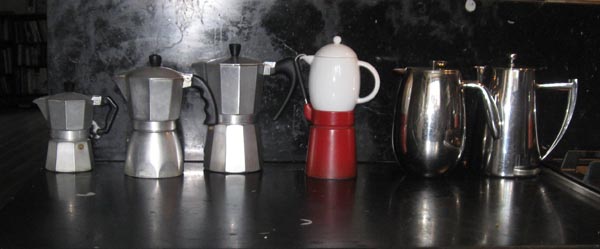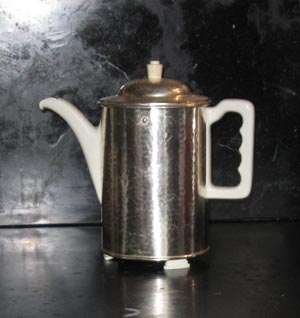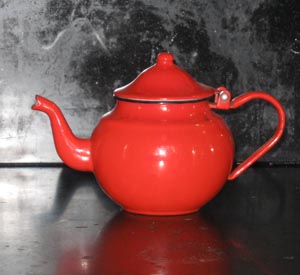In the Eighties I worked for George and Susie Gossip in Ballinakill House in Waterford.
Susie’s father, Luke, had been the managing director of a large advertising agency in Dublin and found it a great ice-breaker at, frequently attended , dinner parties to ask a neighbour “How do you heat your water ?”
There followed inevitably a discussion on the respective merits of oil, coal, gas, wood, anthracite and electricity.
Another ice breaker is to ask “How do you make your coffee ?”
There follows a discussion of the fans of filters, plungers, espresso machines, “You cannot beat an ordinary coffee pot” purists and even those (my own food heroine Elizabeth David among them ) who claim that they cannot tell “Real ” from instant.
Over the years I seem to have settled on two methods.
First thing in the morning, the house to myself and in Robe de Chambre I like a little pot of espresso to jolt me into the day.
For clients then I find you cannot beat the new stainless steel hollow walled jobs.
These men keep the coffee hot for about thirty minutes and operate like a plunger so there is no messing with little strainers.

From the left here is my Batterie de Café
The first three are the Italian Espresso makers.
Here you load coffee in the middle section, and fill the bottom with water.
This is put on the gas and the steam, forced through the coffee, condenses and delivers a pungent brew to the upper chamber.
The first delivers two little cups, the second four then six.
Great stuff for the morning.
The fourth one is a more genteel version of the first three.
It does exactly the same job but delivers instead into a rather daintier china pot.
The last two are my stainless steel ones.
I gave one of these last year to my sister D who for years had sworn by a particularly obnoxious yellow enamel job with which one had to use a strainer.
This one had a particularly vile habit.
As you poured out the last cup, with stunning accuracy, it would drop it’s lid into the cup, spilling all its contents over you and the table.
The stainless model managed to usurp the pivotal role of the yellow peril but I suspect it still lurks in their house somewhere.
But just when one is assuming that a modern breakthrough in Coffee Pot style had occured our friend Petra bought thie one in a Brocante in Trebes last month.

It is a German model from the twenties and is practically identical in function to the new ones.
The pot fits into a chrome sleeve lined with felt which insulates as well as the steel.
Because it does not posses an inbuilt filtration device we use it, with great success, for those lesser mortals who believe tea to be an appropriate breakfast drink.
But lest we get carried away below is the tea pot which stood us in great stead for our first two years of camping in Le Presbytere.
The great advantages of this little Polish model (a first cousin of my sisters yellow abomination) are that you need no kettle so you can bring it to the boil on the gas and then add tea.
Also it has a cunning catch on the lid which stops it dive bombing into cup.


Comments
j
on June 6, 2010Water heating has had a comeback as a topic of conversation – oil, coal, gas, wood, anthracite and electricity. Solar, wind, geothermal, photovoltaic, heat exchange, domestic heat recovery. Hmmm…..eco-bling sometimes!
David
on July 16, 2010That ‘obnoxious yellow enamel job’ was a joint Christmas present given to your sister by her 9 and 10 year old son and daughter (which probably explains why it was tolerated for so many years). I think it’s fair to say that whatever it lacked in style and fucntionality, it more than made up for in durability! We learnt soon enough that it was necessary to keep a thumb firmly on the lid when pouring the last cup if you didn’t want to spew the dregs of the pot all over the table, but sometimes we allowed guests (and relatives) to find this out for themselves.
The comments are closed.